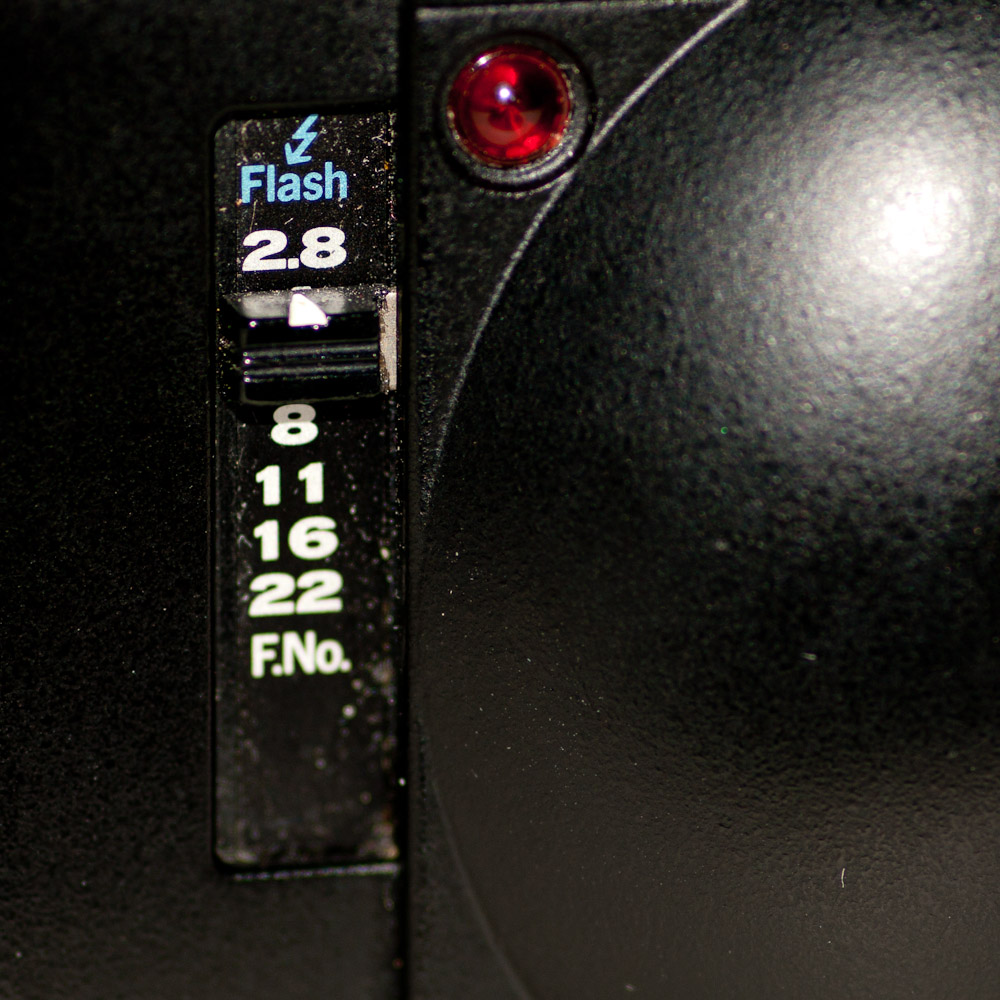Dec
10
2012

A camera that’s more about style than function. I had hoped that its having a 35mm lens would put it on par with the lens of the Stylus Epic but that camera has an f2.8 maximum aperture vs the 3.5 of the LT-1. The epic is all around a better camera it just isn’t wrapped in a nice fake brown leather. And that’s all I have to say about that.
1 comment | tags: camera, film, olympus | posted in Cameras, Photography
Aug
7
2012

The Olympus Trip is a very interesting camera for several reasons. It does not require a battery because it has a selenium meter around the lens that powers all the automatic metering functions. It’s a zone focus camera so you need to estimate the distance to your subject. These two things together make a camera that is very good at being always ready. There is no worrying about exposure, it’s out of your control, and if you pre-focus to a set distance then it’s easy to snap a picture the moment you want without any delays. It’s also relatively small and a nice design that the newer mirror-less Olympus camera’s owe a nod to. It has a 40mm lens that is a nice compromise of a focal length not to wide and not to long, just right. There is a lot of information about this camera if you just ask the the all knowing internet, so I won’t cover that but I just wanted to reiterate how easy it is to use and the results from it can be decent.
no comments | tags: film, olympus | posted in Cameras, Photography
Jun
24
2012

Heavy on the style and epicness. This was a camera that sold very well for Olympus, in the millions, so there are many out there to be enjoyed and they really should be. At it’s core it is a 35mm 4 element f2.8 lens that is very sharp without a lot of distortion, but with a bit of vignetting. It is a point and shoot and therefore doesn’t offer many overrides, primarily control of the flash but it focuses well and the exposure is almost always spot on. It is a very small camera which easily slips into a pocket. The fact that it turns on by simply opening the clam shell makes it easy to prepair for use without needing to look at the camera to locate the on button as is the case with many other cameras. The Stylus Epic out performs it’s current cost ten times over and deserves it’s cult status.
More samples shots from the Olympus Stylus Epic
5 comments | tags: Cameras, film, olympus | posted in Cameras, Photography
Apr
11
2012

There is plenty of good information about the Olympus OM-1 and the other cameras in this series on the Internet so I don’t feel that I need to cover that ground. I will however take a moment to discus the metering and how it is measured and presented to the user.
The OM-1 has TTL metering (Through the lens) that is provided by two Cds cells placed internally around the eyepiece. A certain portion of the light passing through the viewfinder prism falls on these cells causing their internal resistance to drop. This effects the circuit causing the meter needle to move. Other parts of this circuit are the ASA dial, on off switch and of course the shutter speed and aperture linkage. All these variables contribute to the position of the meter needle. This meter requires batteries to operate but the camera it self is entirely mechanical allowing you to shoot without the meter.
The meter itself is located on the left hand side of the viewfinder and gives an indication of proper exposure for an average scene. As you make changes to the aperture and shutter the needle moves correspondingly. As the lens remains at it’s maximum aperature prior to actually taking a picture these changes are transferred from the lens to the camera via a mechanical linkage. In addition to centering the needle you can determine +-1 EV of adjustment in half stops by comparing the needle to the markings in the viewfinder. I’ve created this animation to show these.

My camera has an interesting focus screen that does not have the standard central focus micro-prisms or split image but is essentially a matte screen with a finer circular matte at the center and frame lines that are well within the image. I believe this was the all matte type that someone has customized with frame lines for either astrophotography or as Ted Samzadeh of Omnilargess has suggested for medical imaging. In any case the fine matte screen provides an exceptionally clear and unobstructed view.

Here are some of my ubiquitous sample images from my OM-1 taken with the Zuiko 35-70 F3.6 or the 28mm F 3.5 Zuiko as these are the only two lenses I currently own. Duncan Turner of DLT Photographic has now lent me a Vivitar 55mm macro in OM mount so that should be an interesting lens to try out with this camera.
3 comments | tags: camera, film, Meter, olympus, OM1, viewfinder | posted in Cameras, Photography
Oct
17
2011

As the Canon Classic and the Pentax 24EW (pronounced 2-4-EEEEEeeeewwwww) fought it out to be the supreme irrelevant the Olympus mju III was waiting for it’s moment. In a move reminiscent of Doc Brown it has vualted forward from 2003 and staked it’s claim to be the preeminent irrelevant camera from around the turn of the last century. It’s 37.5-150mm (really 1/2 a mm wider you coun’t have rounded?) lens is something to behold. That’s 150mm in a Point and shoot! I’m not aware of any PS film cameras that had a longer lens.
So why wouldn’t it just win hands down, it’s lens is the longest? The reason is that it lacks much of the control that the Pentax and Canon have such as exposure compensation and that neat feature of automatic zoom for portraits. Features like that really help when your trying to be the best of the abandoned. And the Olympus is champagne coloured, please that is so 2000. The Canon and the Pentax are a “real” camera colour silver, which isn’t really a colour because it’s just a reflection…..
 So how did it perform? It took some getting used to because it seemed to want to use the flash all the time every time. This was annoying and required me to poke at teeny little buttons until the flash symbol was off every time I turned the camera on (camera on-flash off-camera off-flash on-camera on-flash off) I think you get the idea. The one feature it has and luckily is useful is the spot metering.
So how did it perform? It took some getting used to because it seemed to want to use the flash all the time every time. This was annoying and required me to poke at teeny little buttons until the flash symbol was off every time I turned the camera on (camera on-flash off-camera off-flash on-camera on-flash off) I think you get the idea. The one feature it has and luckily is useful is the spot metering.
The results though were good, again if good had stayed the same since 2003 but good is better now than it was then, (flash-off) After all this which one would I choose you might ask if you cared. The thing is they all have a certain charm. The Pentax for it’s control and 24mm wide lens, the Canon for it’s looks and image quality and the Olympus for it’s 150mm long lens. If you thought choosing a camera a decade ago was hard it’s far worse now. There are more categories of cameras and more cameras in each category and new one replace old ones at a rate that even the all mighty internet can’t keep up with.
I hope you’ve enjoyed this little blast from the resent past, and take a moment to reflect just how much has changed between 2003 and 2013 (note if it isn’t 2013 when you read this ignore that)
1 comment | tags: Cameras, film, olympus | posted in Cameras, Photography
Sep
22
2011
Small is beautiful as far as I’m concerned when it comes to cameras. Here are some frames from my Olympus XA which is the smallest true rangefinder that I own. I wish that I could design my own camera free of any concerns about money or infinging on copyright or purhaps the laws of physics. It would end up being pretty small and not necesarily have a lot of features beyond easy controls, something like a digital Olympus XA maybe?

Here is the XA nestled next to the Pentax K10D with grip, which wouldn’t be confused for a small camera, unless you were a gaint.
no comments | tags: film, olympus, Xa | posted in Cameras, Photography
Jul
16
2011
 I’m a visual person so I think that a picture is often the best way to explain something. This is the cover for the rangefinder adjustment for the Olympus 35-S. Once this cover is removed you can insert a suitable slotted screwdriver and gently turn the screw until the rangefinder image merges with the rest of the scene when the lens is set to infinity. So when done an object at infinity should match giving a single image within the rangefinder patch.
I’m a visual person so I think that a picture is often the best way to explain something. This is the cover for the rangefinder adjustment for the Olympus 35-S. Once this cover is removed you can insert a suitable slotted screwdriver and gently turn the screw until the rangefinder image merges with the rest of the scene when the lens is set to infinity. So when done an object at infinity should match giving a single image within the rangefinder patch.

2 comments | tags: adjustment, olympus, Rangfinder | posted in Cameras, Photography
May
10
2011
Some shots from outside the hotel I had meetings at all last week.
no comments | tags: film, olympus, Xa | posted in Photography
May
6
2010



Where do you see rectangles, everywhere? If you can imagine the world in front of you as a flat two dimensional plane it can be an interesting exercise to look for ways to divide it. It can be helpful to look through the viewfinder to generate that flat view and frame a scene but with practice you can spot images without the camera. So why would you want to do this? Like any exercise in seeing it helps to broaden your visual acuity.
no comments | tags: camera, composition, design, film, olympus, Photography, xa2 | posted in Composition, Photography


 Another major difference is that the XA uses rangefinder focusing instead of the simple zone focus system of the XA2 and the final difference being that the XA is aperture priority with the shutter speed shown via a needle in the viewfinder and the XA2 is completely automatic with no feedback.
Another major difference is that the XA uses rangefinder focusing instead of the simple zone focus system of the XA2 and the final difference being that the XA is aperture priority with the shutter speed shown via a needle in the viewfinder and the XA2 is completely automatic with no feedback. 
 So obviously the XA has many advantages that provide for greater photographic control. That isn’t the end of it though because using the XA2 is a great shooting experience. Giving up some control you gain back in speed of operation and can turn more attention towards the image you intend to make.
So obviously the XA has many advantages that provide for greater photographic control. That isn’t the end of it though because using the XA2 is a great shooting experience. Giving up some control you gain back in speed of operation and can turn more attention towards the image you intend to make.

























































































